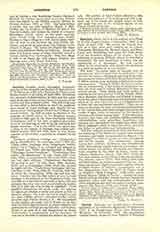

Carrieres, LOUIS DE, b. in the chateau de la Plesse in Avrille, Angers, France, September 1, 1662; d. at Paris, June 11, 1717. He entered the French Oratory at a time when such masters as be Cointe, Thomassin, Malebranche, Richard Simon, and Bern. Lamy were flourishing, and made the Holy Scriptures the favorite subject of his studies. In his solicitude to promote Biblical science he founded a scholarship, the first beneficiary of which was the well-known C. F. Houbigant. He held various offices in his community, and earned the reputation of a priest as modest as he was learned.
His work, “La Sainte Bible en francais, avec un commentaire litteral insere clans la traduction”, has won for his name a widespread and long-lived celebrity among the readers of the Holy Scriptures in French. It differs entirely from anything published by former commentators. Taking be Maistre de Sacy’s translation as a framework, a few words of paraphrase are here and there used to explain difficulties or clear up obscure places. These simple and short additions, inspired for the most part by Vatable, Tirinus, Menochius, Bonfrere, and Jansenius, and printed in italics, are at first glance discernible from the text itself, with which at the same time they are so amalgamated as to form but one continuous narrative. There are no notes to interrupt the text; no tiresome enumerations of the various interpretations brought forward in the course of ages; hence no necessity for the reader to compare and choose among them. A few blemishes, however, mar these real qualities; besides occasional mistranslations, some groundless hypotheses and opinions now antiquated, the reader may think that better judgment could at times have been shown in the choice of authorities and interpretations.
The first volumes published at Paris and Reims in the beginning of the eighteenth century were heartily welcomed and highly recommended by Bossuet, who encouraged the writer to pursue his work and augured well for its success. The commentary, forming twenty-four volumes, duodecimo, was completed in 1716. New editions rapidly followed one another: the second edition with preface, summaries, and dissertations compiled by the Abbe de Vence, twenty-two volumes, duodecimo (Nancy, 1738-1741); third edition, five volumes, octavo (Paris, 1740); fourth edition, ten volumes, octavo (1747); fifth edition, with maps and illustrations, six volumes, quarto (1750), etc. Carrieres’ paraphrase, slightly corrected, together with an abridged revision of Calmet’s commentaries and a few dissertations from the Abbe de Vence, made up Rondet’s “Bible d’Avignon” (1748-1750), widely known later as “Bible de Vence”. During the nineteenth century Carrieres’ version has been frequently reprinted, often with the commentaries of Menochius, sometimes also with the notes of modern interpreters, like Sionnet (1840) and Drioux (1884).
CHAS. L. SOUVAY,

